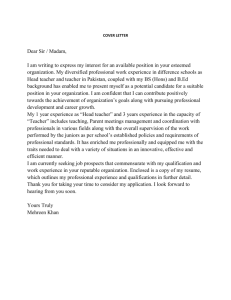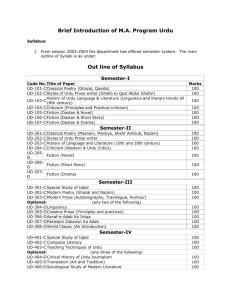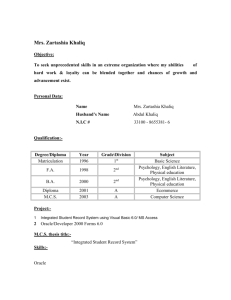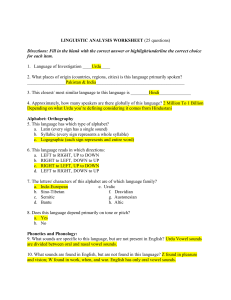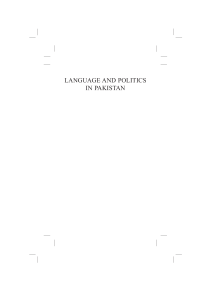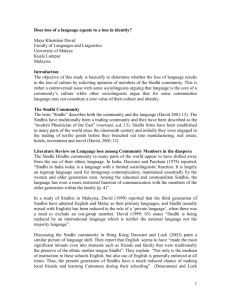Pakistan Pakistan and its Languages The linguistic situation in
advertisement
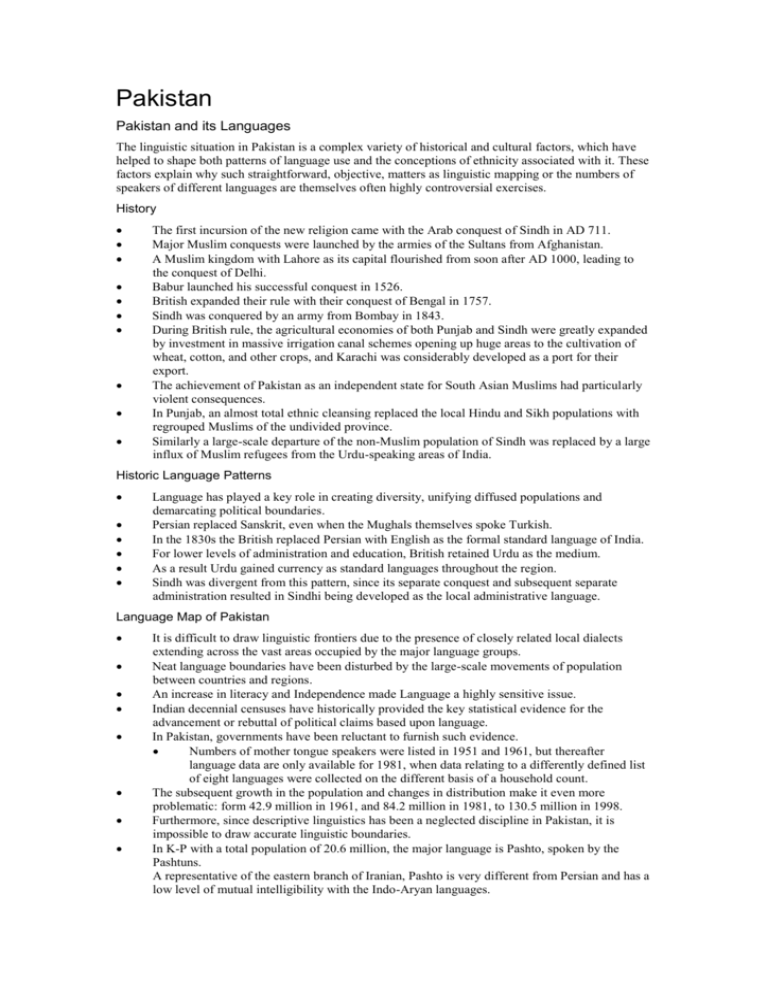
Pakistan Pakistan and its Languages The linguistic situation in Pakistan is a complex variety of historical and cultural factors, which have helped to shape both patterns of language use and the conceptions of ethnicity associated with it. These factors explain why such straightforward, objective, matters as linguistic mapping or the numbers of speakers of different languages are themselves often highly controversial exercises. History The first incursion of the new religion came with the Arab conquest of Sindh in AD 711. Major Muslim conquests were launched by the armies of the Sultans from Afghanistan. A Muslim kingdom with Lahore as its capital flourished from soon after AD 1000, leading to the conquest of Delhi. Babur launched his successful conquest in 1526. British expanded their rule with their conquest of Bengal in 1757. Sindh was conquered by an army from Bombay in 1843. During British rule, the agricultural economies of both Punjab and Sindh were greatly expanded by investment in massive irrigation canal schemes opening up huge areas to the cultivation of wheat, cotton, and other crops, and Karachi was considerably developed as a port for their export. The achievement of Pakistan as an independent state for South Asian Muslims had particularly violent consequences. In Punjab, an almost total ethnic cleansing replaced the local Hindu and Sikh populations with regrouped Muslims of the undivided province. Similarly a large-scale departure of the non-Muslim population of Sindh was replaced by a large influx of Muslim refugees from the Urdu-speaking areas of India. Historic Language Patterns Language has played a key role in creating diversity, unifying diffused populations and demarcating political boundaries. Persian replaced Sanskrit, even when the Mughals themselves spoke Turkish. In the 1830s the British replaced Persian with English as the formal standard language of India. For lower levels of administration and education, British retained Urdu as the medium. As a result Urdu gained currency as standard languages throughout the region. Sindh was divergent from this pattern, since its separate conquest and subsequent separate administration resulted in Sindhi being developed as the local administrative language. Language Map of Pakistan It is difficult to draw linguistic frontiers due to the presence of closely related local dialects extending across the vast areas occupied by the major language groups. Neat language boundaries have been disturbed by the large-scale movements of population between countries and regions. An increase in literacy and Independence made Language a highly sensitive issue. Indian decennial censuses have historically provided the key statistical evidence for the advancement or rebuttal of political claims based upon language. In Pakistan, governments have been reluctant to furnish such evidence. Numbers of mother tongue speakers were listed in 1951 and 1961, but thereafter language data are only available for 1981, when data relating to a differently defined list of eight languages were collected on the different basis of a household count. The subsequent growth in the population and changes in distribution make it even more problematic: form 42.9 million in 1961, and 84.2 million in 1981, to 130.5 million in 1998. Furthermore, since descriptive linguistics has been a neglected discipline in Pakistan, it is impossible to draw accurate linguistic boundaries. In K-P with a total population of 20.6 million, the major language is Pashto, spoken by the Pashtuns. A representative of the eastern branch of Iranian, Pashto is very different from Persian and has a low level of mutual intelligibility with the Indo-Aryan languages. Balochistan, with its population of only 6.5 million speaks Balochi is quite closely related to Persian. The centre of the province is home to Brahui, a strangely isolated member of the Dravidian language family otherwise largely located in India. Sindhi has preserved many Indo-Aryan features. After 1947 Mohajirs established a major presence in the cities of Sindh, especially in Karachi. With 30 million people in 1998, Sindh has the sharpest linguistic divisions. Punjab houses 60% of Pakistan’s population, (72.6 million plus another 800,000 in Islamabad in 1998). Since majority of refugees come from the eastern districts of the Punjab, there was much less disruption to the previous linguistic homogeneity than occurred in Sindh. Within this large region, however, there has always been quite significant linguistic differentiation. What might be called ‘Punjabi proper’ is spoken in the prosperous central districts around Lahore. Punjabi as spoken in these areas is linguistically the closest to Urdu. Some of the other languages are: Siraiki, Hindko, and Mirpuri. National Language Policy Pakistan emerged as a multilingual country inheriting English as the language of colonial administration, with Urdu retaining powerful symbolic value as a marker of Muslim identity. Urdu and Islamic Identity After the traumatic consequences of War of Independence of 1857 Muslims tried to re-group to face increasing privileges for Hindu majority, granted by the British. Urdu became the medium for an intense debate. It came to be regarded as a symbol of an embattled Indian Muslim identity This identification was enhanced by the success of the Hindu-led movement, which deliberately substituted Sanskrit. In the undivided Punjab with its Muslim majority Urdu was not only the official language of the province but also possessed a strong appeal to most educated Punjabi Muslims. The multiple roles of Urdu in British India as the vehicle of poetry of wide appeal, of Islamic teaching, and of nationalism were combined in the work of the greatest Lahore-based Urdu writer, the poet-philosopher Muhammad Iqbal (1879–1938), who came to be regarded as the spiritual father of Pakistan. Lahore thus became established as a centre of Urdu in northern India. Urdu and Bengali Due to administrative requirements Pakistan retained English as the official language, initially. On the other hand some favored Arabic being the sacred language of Islam. Urdu – the language of Islamic identity in the Indian sub-continent – seemed a logical compromise for both the national and official language. Jinnah, although had a famously poor command of Urdu, favored this stance. Bengal had an exceptionally highly developed sense of local cultural identity. Outside a tiny Urdu-speaking elite, this identity was strongly associated with Bengali language. Although written with a distinctive Indic script, it was spoken by virtually the entire population of East Pakistan. Strong opposition was voiced against Urdu as the national language of Pakistan. Even Jinnah himself was shouted at when he told a mass meeting in Dhaka in 1948 that ‘the state language of Pakistan is going to be Urdu and no other language. Anyone who tries to mislead you is really an enemy of Pakistan’. 1952: 4 students were killed by police fire on protesters following a pro-Urdu declaration. 1955: One Unit created to appease the Bengali separatists. It ended in 1970. Ayub Khan imposed dual language formula, which gave equal status to Urdu as the language of the West and Bengali as the language of the East, while in practice favoring Urdu. When Mujibur Rahman won the elections, army moved in fearing the break-up of the country. Pakistani military repression provoked Indian intervention and led in 1971 to the creation of Bangladesh as an independent Muslim state with Bengali as its national language. Urdu and English An early death of Jinnah and the absence of an established political leadership led to power being substantially invested in the senior bureaucracy. Mohajirs who earlier predominated soon gave way to increasing numbers of Punjabis in the senior ranks of the civil service. Ayub Khan (Army) recognized the continued need for English in the country’s development, while also supporting the use of Urdu as an instrument for national unity constructed around Islamic sentiment. This allowed little room for linguistic ethno-nationalisms. Article 251 of the Constitution of 1973 proclaims: (1) The National Language of Pakistan is Urdu, and arrangements shall be made for its being used for official and other purposes within fifteen years from the commencing day. (2) … English language may be used for official purposes until arrangements are made for its replacement by Urdu. English by now was perceived as the language of power and prestige, closely associated with the privileged elite, versus Urdu as the language of pro-Islamic national sentiment. With General Zia ul Haq’s regime being the first overtly Islamist regime, there a decisive shift in national language policy towards Urdu. 1979: National Language Authority created ‘to consider ways and means for the promotion of Urdu as the national language of Pakistan and to make all necessary arrangements in this regard’. But while the large numbers of scientific and other neologisms were created, it proved much harder to achieve a fundamental shift. Whatever the emotional appeal of Urdu as the language of Islam or as the symbol of Pakistani national identity, it is English, which continues to be seen as the key to status and success. Languages and Ethnicities Pakistani national identity was originally conceived in purely religious terms. The official rhetoric still emphasizes the separateness and distinctiveness of the Pakistani from the Indian national identity. In Pakistan with its long fear of India, protection of the nation has been of overriding importance for all regimes. The articulation of linguistically defined ethnicities within Pakistan therefore continues to be problematic, partly due to the difficulty in defining the relationship between national identity and local ethnicities. In Pakistan, formal standard languages and local speech continues hierarchically between English, Urdu, and the local language. The movements which have variously arisen in different parts of Pakistan to advocate an enhanced status for the local language seek to disturb this pattern. Hence these are thwarted by the Centralist stance by the state. Through recognition of the language as medium of education, and administration, these movements usually translate as political demands for the allocation of scarce resources. Language movements begin with cultural and linguistic activities by middle class enthusiasts who work for the enhancement of a sense of local ethnicity, through a revaluation of the local cultural and literary heritage and a redefinition of local speech as a distinctive language. Sindhi and Urdu Prior to 1947 British language policy favored the official use of Sindhi. Arabic script required to record distinctive Sindhi sounds was formulated. Sindhi was used both in schools and colleges and in government offices. A considerable literature was also produced by both Muslim and Hindu writers. This cultural cohesion was shattered after 1947 by the emigration of most Sindhi Hindus to India and the massive influx of Urdu-speaking Mohajirs. In Karachi and Hyderabad they outnumbered the Sindhi population. The prominent national role of the Mohajirs coupled with the encouragement of Urdu as the national language, resulted in the diminution of the role of Sindhi, which lost its official status with the amalgamation of Sindh in the One Unit scheme. A Sindhi Language Bill was introduced by the provincial government in 1972, promising a substantial restoration of the pre-1947 status of Sindhi. Language riots aroused by violent Mohajir left them frustrated. G. M. Syed’s ‘Sindhu Desh’, advocating the complete removal of Urdu, found no major support. On the other side, the marginalization at the national level of the Mohajirs by a new alliance between Punjabis and Pashtuns denied Mohajirs exclusive national identity for themselves. Altaf Hussain proposed Mohajirs as the ‘Fifth nationality’ of Pakistan, along with the Sindhis, Punjabis, Baloches, and Pashtuns. All nationalities are defined by their provinces, so this entailed the demand for the Karachi region to become a separate province to be dominated by the Urdu-speakers. Punjabi and Siraiki In Punjab, language movements are typically the creation of groups which see themselves as neglected or oppressed. Dominance of Urdu in Punjab (established in the colonial period) has been reinforced by the great success of the Punjabis themselves in dominating most sectors of national life in Pakistan. The argument that the Punjabi identity should be recognized by an enhanced status for Punjabi has therefore lost footing. The success of the Sikhs in India in creating a linguistically defined state has certainly been an inspiration for the Punjabi activists in Pakistan. Efforts to establish a new conception of Punjabi have here been hindered not only by the very closeness of Punjabi to Urdu, but also by the perception of it being the Sikh language. Siraiki movement is a classic illustration of modern language movement: an association between language and a sense of oppression. Siraiki activists pursued the usual strategies in enhancing an awareness of the language and its cultural heritage. Linguistically, in seeking a maximum differentiation from Punjabi, much has been made of different constructions of overlapping literary pasts and linguistic classifications. Particular emphasis has been laid on the phonetic distinctions from Punjabi which Siraiki shares with Sindhi, notably the implosive consonants. Although Siraiki is spoken in adjacent regions of all the other provinces, the campaign for its recognition has been focused within Punjab, including the demand for the division of this disproportionately populous province. Urdu to be replaced by the mother-tongue as the medium of primary education in the province sets proponents of Punjabi and of Siraiki against one another. Conclusions Pakistan is an example of a multilingual country whose failure to evolve strong institutions seems due to the linguistic implications of a whole variety of conflicting definitions of national identity and local ethnicity. So while the nature of division in Punjab is qualitatively different from Sindh, the rivalry between locally opposed linguistic ethnicities is sufficient to allow the central government to encourage a continuance of the status quo.
